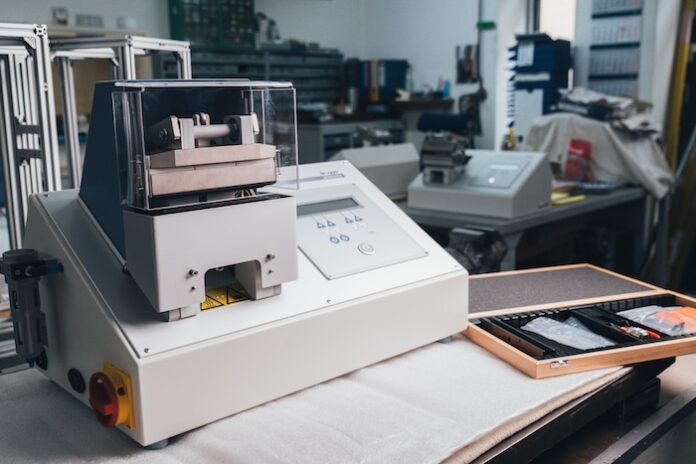Flawless packaging is a crucial component throughout the entire production and storage chain. It is essential for the safety and shelf life of food products. Until now, undetected microcracks, faulty seal seams, or inconsistent test results have put quality at risk, led to unwanted complaints, and, in the worst case, resulted in costly product recalls. Brugger Feinmechanik, based in Munich, Germany, offers a specialized range of heat-sealing machines and related equipment designed to address these challenges.
These systems allow reliable seals to be created, documented, and subsequently evaluated under precisely controlled conditions. Additionally, permeation testers measure the barrier properties of films, ensuring that packaging continues to provide its protective function. Users – particularly in the food industry, as well as in laboratories and research institutions – benefit from solutions that enhance safety and document quality. Brugger’s equipment has also proven effective in many other industries over the decades. With Brugger’s testing and sealing systems, manufacturers can reliably meet stringent product and production requirements, verify packaging integrity, and safeguard their processes for the long term.
“Even the smallest leaks in seal seams can significantly compromise shelf life and product safety. Without precise testing and measurement technology, such risks often go undetected,” says Maurice Dinkelbach, managing director and owner of Brugger Feinmechanik GmbH in Munich.
Precise packaging tests ensure quality, shelf life, and product safety
Packaging is exposed to a wide range of stresses in everyday production. Throughout its entire life cycle – from transport and storage to presentation at the point of sale – it must maintain its sealing integrity to meet the quality standards required by manufacturers, retailers, and consumers. Even the smallest microcracks in films or poorly sealed seams can quickly lead to problems. Gases may escape or enter, the protective atmosphere can be compromised, and moisture can penetrate, significantly shortening the shelf life of food products or causing spoilage. For manufacturers, this can lead to increased complaints, reputational damage, and considerable financial losses due to poor packaging seals. Another issue is the lack of comparability of test results along the supply chain. Different testing methods and equipment often produce inconsistent results among manufacturers, bottlers, and laboratories, complicating coordination and increasing uncertainty.
Brugger Feinmechanik addresses these challenges with a systematically organized range of compatible specialized devices that are widely used across the industry. This ensures transparency in testing, better comparability of results, and greater reliability. Users can trust the results, regardless of where in the production workflow they are obtained. In particular, the HSG-CC (heat sealing machine) and GTT (gas transmission tester) are central components for packaging sealing and quality assurance. They are robust, durable, and designed for practical use – often developed in close collaboration with customers or research institutions.
“We at Trüb Emulsions Chemie AG in Ramsen, Switzerland, have been operating in the chemical industry since 1978. Since 1988, Brugger’s heat-sealing tester has delivered precise and reliable results, performing flawlessly to this day. At the time, we were testing new types of plastics for their weldability,” Mr. Nicolas Pfetsch, Head of R&D, explains. “Based on these experiences, we decided to acquire an additional unit. The decisive factors included long service life, ease of operation, measurement reliability, and Brugger’s excellent service. Based on our experience, we can fully recommend purchasing a Brugger device.” The Munich-based company deliberately focuses on a small number of highly specialized devices, which are continuously developed. Producing reliably sealed packaging that preserves protective atmospheres such as nitrogen or carbon dioxide (CO₂), meets sterilization requirements, and ensures shelf life is essential – particularly in the food and pharmaceutical industries.
Comprehensive food packaging sealing tests from a single source – ensuring maximum quality and product safety
Brugger’s testing and measurement systems follow a systematic process that evaluates packaging under realistic conditions. First, the mechanical durability of the films is simulated, for example using the KFT-C (flex durability tester) according to the Gelbo Flex Method (ASTM F-392), to detect crease resistance and potential micro damage that may occur during filling, transport, or storage. The next step is permeability testing with the GTT, which measures how much oxygen (as well as CO₂ or other gases) passes through a film – particularly when barrier layers may be damaged. This is especially critical for the food industry, as it directly impacts both shelf life and product safety. Following this, optimal sealing parameters are determined using the HSG-CC or the NDS (low-pressure heat sealer), with temperature, pressure, and time precisely tailored to the material combinations. Finally, the VNG-E (universal tensile tester) assesses the strength of the seal seams and provides values for adhesion, coefficients of friction, and mechanical strength. Brugger thus provides a comprehensive system, covering everything from mechanical simulation to final seal seam testing. This ensures manufacturers receive clear, comparable results and allows for targeted optimization of their packaging operations.
From gas permeability to seal integrity – reliable seams ensure product integrity and shelf stability
Brugger Feinmechanik offers a broad product range, specifically developed to meet diverse requirements. In the field of leak testing, the GTT is a proven example. It operates according to the differential pressure method in compliance with ISO 15105-1 and measures the gas permeability of films in the range of 0.05 to 10⁶ cm³/(m²dbar) with a resolution of 0.01 cm³/(m²dbar). The sample temperature is regulated via Peltier elements from 15 to 45°C with a stability of ±0.2°C. The humidity and temperature of the test gas are continuously monitored, with optional humidification if needed. This 22-kilogram device only requires a simple rotary vane or diaphragm pump and is operated via a 10-inch touch panel or PC software. The actual sealing process takes place before the seal test.
The second product line focuses on the secure bonding of materials. The HSG-CC enables optimal sealing processes while precisely adhering to the specified parameters. Sealing times from 0.1 to 300 seconds can be set with 0.1-second accuracy. The sealing temperature can be regulated up to 300°C separately for the upper and lower sealing jaws. Sealing force ranges from 40 to 1000 Newton. The devices are available as a benchtop version (24 kg) or as a floor-standing model with its own compressed air supply (76 kg). An optional hot tack testing device is available, along with corresponding documentation software or test equipment monitoring. Both product lines reflect Brugger’s high technical standards. The GTT captures material tightness with extremely fine resolution, while the HSG-CC simulates real production conditions and ensures the quality of the seams. Together, they enable manufacturers to accurately determine material properties and ensure long-term process reliability in packaging production.
Continuous innovation in sealing and testing: from hot tack to digitalization
“Our development is an ongoing process. We are currently working on an enhanced hot tack test, which in addition to the distance measurement method will soon also offer a force-measuring variant. This will allow us to make an even more accurate analysis of the quality of heat-sealed packaging,” says Maurice Dinkelbach. “In the future, this will provide further quality assurance, especially for products that are mechanically stressed immediately after the sealing process. Further steps in digitalization are already underway. Automated documentation and interfaces for databases will open up new avenues for quality assurance.”












